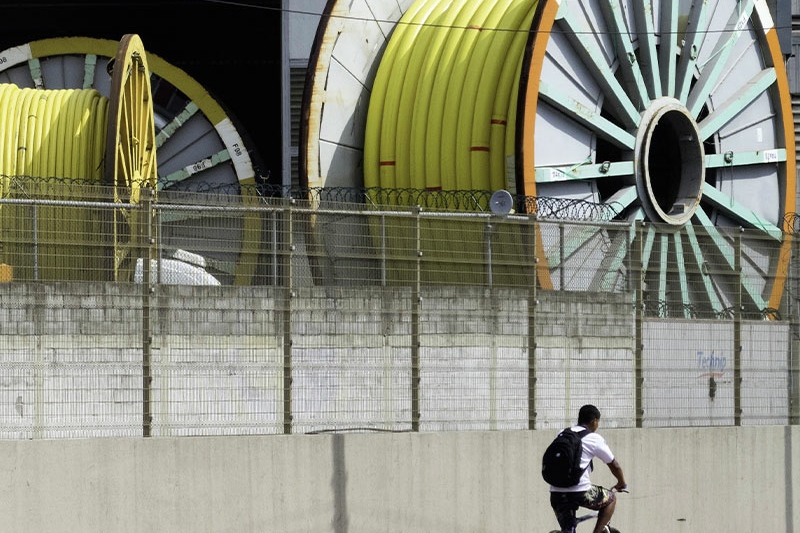Latin American arbitration in transition
A disruptive era portends a new wave of disputes using well-established frameworks for commercial and investment arbitration

By Carlos Viana, Latin America Interest Group Leader and Editor of Latin America Focus
We are delighted to introduce the first edition of Latin America Focus, a publication produced by the Latin America Interest Group at White & Case. Our intent with this publication is to provide market insights from our practices and proprietary research that could be valuable to senior decision-makers who have an interest in the region.
COVID-19 hit Latin America's economies more heavily than it hit any other region around the world. The region's economies contracted by nearly 7 percent in 2020, compared to a global average of only 3 percent. Current projections indicate a healthy recovery through the end of 2021, perhaps by as much as 6.9 percent according to S&P Global,1 and thereafter steady growth of about 2.5 percent per annum.
As we look forward to 2022 – 2023, Latin America, in very significant part, will likely continue to face the ebbs and flows of populism, resource nationalism and weak institutions that seem to take turns at flooding some of the countries in the region from time to time. Yet, we also see Latin America propelled away from the COVID-19 swamp by the powerful global engines of economic, social and technological evolution that will push heavy foreign investment into the region: unprecedented global liquidity and the search for yields in emerging markets, the energy transition, the commitments to mitigate climate change by global natural resources and energy companies, and the technology-driven push to digitize and automate the increasingly global world economy. We saw these global drivers, and foreign investors' net-net belief that Latin America will resurge in the medium term, supporting our cross-border business in the region through a 2020 – 2021 period that we expected at the outset could be cataclysmic for foreign investment in view of the region's endemic challenges.
In this edition of Latin America Focus, partners in our Latin America Interest Group have written articles based on their personal experiences in the trenches and market research that go to the very heart of both the latest sequel in the Latin American saga of transitions, and the current global forces of growth, the interplay of which will likely shape what is to come in post-COVID-19 Latin America.
Times of transition are frequently associated with greater incidences of disputes, notably investor-state disputes, but also commercial disputes, especially in times of supply-chain disruption. In "Latin American arbitration in transition," our team outlines the past and present of commercial arbitration in Latin America, and its prospects for the future.
Latin America has experienced many sovereign debt defaults over the past century. The most recent installment of these usually long-brewing crises played out as COVID-19 partly disabled the region, involving Ecuador, Argentina, Belize and Suriname. Meanwhile, Venezuela continues mired in default for more than three years as of the time of publication. In the article "Sovereign debt restructurings in Latin America: A new chapter," our team explores some of the lessons learned and innovations employed in these recent sovereign debt restructuring exercises, providing insights into the implications for the future of sovereign and sub-sovereign international finance and, more broadly, cross-border restructurings, in the region.
With the COP26 conference being held in Glasgow in November 2021 and concerns about climate change at an all-time high, it is unsurprising that environmental, social and governance (ESG) trends are a recurring sub-theme through several of the articles in this inaugural edition of Latin America Focus. In "Sustainable finance in Latin America," our team focuses directly on green, social and sustainability-linked (GSS) bonds. This article also covers other kinds of sustainable finance, and international environmental agreements in this area to which Latin American countries are signatories.
Our world is being transformed by what the World Economic Forum calls the 4th Industrial Revolution, and Latin America is no exception. Over the next few years, the region is expected to experience faster growth in interconnection bandwidth capacity than any other region in the world. This is especially important for Latin America given the role that connectivity and digital capacity play in driving inclusive economic growth and prosperity. In "Bridging Latin America's digital divide," our team takes a detailed look at investments in digital infrastructure across the region. We focus especially on mobile networks (including 5G), data centers and sub-sea cables, exploring also how these investments are being (and might be) funded.
Latin American equity markets proved remarkably resilient to COVID-19, in terms both of growth in their major indexes and in new initial public offerings (IPOs), and other stock and rights issuances. Brazil, in particular, saw a large number of new publicly listed companies emerge in 2020 – 2021. "Equity capital markets in Latin America" provides a current overview of the state of equity capital markets in Latin America, emphasizing key growth opportunities.
Finally, the first half of 2020 saw a sharp contraction in M&A in Latin America, but deal flow has rebounded strongly in 2021. In "M&A in post-COVID-19 Latin America," our team explores some of the factors that international investors need to take into account when investing in the region's growing markets in view of the current environment. Data drawn from White & Case's global M&A Explorer tool is used to show current trends among various cross-sections of deals.
We do hope that you enjoy reading these insights, and find them valuable. Please do not hesitate to let me know if there are any topics that you would like us to cover in future editions.
A disruptive era portends a new wave of disputes using well-established frameworks for commercial and investment arbitration

Sovereign debt restructuring solutions developed in Latin America during 2020 and 2021 create a new paradigm for sovereign debt restructurings in the region and globally

GSS bonds and other forms of sustainable finance have become a mainstream feature of Latin American debt capital markets

COVID-19 has created strong incentives for investment in digital infrastructure in Latin America, especially in 5G, private networks, data centers and fiberoptic cables

Strong pandemic-era performance and a look around the corner

Established trends driving M&A globally are also reflected in Latin American deal flow


Established trends driving M&A globally are also reflected in Latin American deal flow
Stay current on your favorite topics
With disruptions from 2020 behind us, M&A practitioners have much to reflect upon relating to deals in Latin America. The first half of 2020 saw a steep slowdown in transactions, increased political uncertainty and uneven responses to the pandemic across the region. An eventful presidential election was held in the US, and presidential, mid-term and mayoral elections also took place in some of the largest Latin American economies, including Brazil, Argentina and Mexico. A general election also took place in Peru in April 2021. Dealflow ended 2020 strongly, with the region seeing a significant recovery in M&A transactions. Although the COVID-19 pandemic resurfaced some historical sociopolitical challenges endemic to the region, M&A activity in Latin America appears to be on a path to pre-pandemic levels, driven by the resurgence of its strongest economies.
Despite these risks, there is much reason for investors to be optimistic about their prospects in Latin America.
For bidders, confusing geo-economic and sociopolitical landscapes require careful review of political risk in the acquisition or merger target's host country. Such risk presents itself in many different forms. Examples include changes in public policy, tax laws, governmental approvals proceedings, and legislative or regulatory requirements. Changes in the terms that apply in contracts with government counterparties and to foreign exchange rules or cash repatriation laws can have especially important impacts. Political uncertainty might even trigger a downgrade of the sovereign credit rating of the host country and consequently on the credit ratings of local issuers. Tough times sometimes force governments to take drastic measures. Wise investors know that within limits of investment protection treaties, and agreements and norms of international law, any country (not just in Latin America) is at liberty to pass new laws as their legislatures see fit, to address the most pressing needs of their people.
As in other emerging markets, successful investors in Latin America understand these risk factors and the unique characteristics of the region. They carefully study the region's nuances, both from a cultural and business perspective, the efficacy and limitations of the host country's legal system in enforcing the rule of law, and the investment protection framework afforded by any applicable investment treaties. Once the savvy investor identifies the aforementioned factors, she anticipates market competitors in order to have the upper hand in her investment. All of these factors can have a direct impact on the return achieved on investment (ROI) and even the success or failure of the merger or acquisition. Investors need also to be familiar with the political and legislative cycle of the host country, not least because that can provide a valuable edge during negotiations. Understanding the differences between legal systems and the protections that they afford allows investors to price assets more accurately. It is no coincidence that those who put the right level of emphasis on these factors from the outset of a transaction usually achieve the best outcomes, both in the transaction itself and in the subsequent post-merger integration and operations. Deep understanding of drivers of a deal's success can yield good dividends.
Investors should always base long-term investment decisions on the reality that new administrations following elections might have different views on policies and social issues. They might make changes that impact the investor and the potential ROI that the transaction might yield, or even its overall feasibility. Populist, nationalist policies adopted by several governments in Latin America during the pandemic emphasized the need for investors to pay close attention to all investment protections at hand—both in terms of the efficiency of the host country's court system in enforcing the rule of law or under the countrdy's multilateral and bilateral treaty networks.
Despite these risks, there is much reason for investors to be optimistic about their prospects in Latin America. Resilience and growth became evident in the largest economies in the region during the second half of last year, and this has maintained momentum into the first half of 2021. The current year commenced with a year-on-year increase in M&A, with a healthy pipeline especially from the middle-market to the larger players. As the year progressed, M&A activity has been inching toward the levels that existed prior to the pandemic (see figure 1).
This trend is not accidental. Continued growth of the region's consumer base makes Latin America a promising investment prospect. Its young population is eager for high-quality urbanization and infrastructure, better and more efficient services, and faster and more effective technologies. The MSCI Emerging Markets Latin America Index, which captures large- and mid-cap representation across the six largest economies in Latin America, shows that year-to-date returns for the first half of 2021 in those markets outperform the returns shown in other emerging markets.
On the procedural front, the willingness of local counterparties to run acquisition processes more institutionally through investment bankers or international financial advisors, as well as to rely on more conventional international M&A structures, such as stock-for-stock acquisitions, reverse triangular mergers and similar business combinations that are popular in the US and Europe, have added much needed comfort to market participants in the region and is certainly resulting in increased deal activity. Similarly, the propagation of representation and warranties insurance in Latin American deals is making acquisition processes more efficient, as it offers sellers the chance to achieve a cleaner exit and buyers a more expedited remedy against insurance companies in US courts. These factors, together with the fundamental drivers in the local economies summarized below, are making the region more attractive and giving dealmakers a more leveled playing field to pursue regional M&A opportunities more aggressively.
Some economies and industry sectors proved more resilient than others during the COVID-19 pandemic. Brazil, for instance, contributed to almost 60 percent of the regional announced M&A transactions, followed by Mexico, Chile, Peru and Colombia (see figure 2). Brazil also pushed through its long-anticipated privatization agenda and implemented several structural changes that boosted economic activity in the country prior to the pandemic. The devaluation of the Brazilian real, coupled with very low interest rates in some of the major developed economies, also created a significant volume of M&A transactions that continues to feed deal activity in the region.
Countries such as Mexico, on the other hand, adopted a more antagonistic approach toward foreign investors. The country's government pursued a more nationalistic agenda in its energy sector that, for much of 2020 and so far in 2021, has significantly slowed down foreign direct investment (FDI) into that sector.
Because of the outcome of its recent general election, Peru is currently an enigma in the region. The country has good fundamentals and a solid track record of M&A transactions. However, many investors are wary of the risk of regulatory and policy changes. Some investment decisions are being delayed until greater clarity exists about the direction that the new administration intends for the country.
Latin American M&A is generally known for its large number of cross-border transactions, both incoming and by Latin American bidders into other regional markets, and beyond. Over the past two years, Brazilian acquirers have been the regional leaders, with almost US$85 billion reported cross-border acquisitions. This amount is almost twice as much as FDI from the US, which is historically the most active acquirer in the region. Acquirers from France, China, Spain, Canada, Japan and Italy along with Chile and Colombia have followed suit (see figure 3). This deal activity is mainly driven by private capital, funds and strategic investors looking to diversify into the region, low interest rates and, in the case of Brazil, by an investor-friendly policy that has facilitated M&A activity across borders.
Deal activity during H2 of 2020 and H1 of 2021 has mainly been concentrated in three major sectors: energy, mining and utilities (including infrastructure), financial services and technology. Energy and infrastructure sectors, especially related to power, have performed notably well. Diversifying fossil-fuel power generation into renewable energy and transmission assets is pivotal for regional governments to drive economic development and energy security while simultaneously meeting their environmental, social and governance (ESG) commitments under the Paris Agreement and other related multilateral agreements to reduce greenhouse gas (GHG) emissions. The COVID-19 pandemic might have slowed down the implementation of such plans, but the long-term intent of regional governments to transition into more sustainable energy policies remains undeterred. Legislation currently under consideration in Chile, for example, will likely end coal-fired power generation in that country by 2025. Brazil has committed to a 37 percent reduction from 2005 GHG levels by 2025, and a 43 percent reduction by 2030.1 The upcoming COP26 conference in Glasgow in November will sustain focus on these issues through the remainder of 2021, and into 2022 and beyond.
Governments are not alone in driving this transition. Investors too are experiencing increasing pressure from their constituencies and management to divest equity positions in conventional power assets and to replace them with clean energy assets that can help achieve their own ESG objectives. Also, prices of renewable energy technologies are at record lows today, as is the cost of funding, making the transition less expensive than it would have been just a few short years ago.
This transition will continue to generate a great amount of M&A work in the region, and we expect Brazil and Chile to lead the market. Colombia's National Program of Greenhouse Gas Tradable Emission Quotas (Programa Nacional de Cupos Transables de Emisión de Gases de Efecto Invernadero or PNCTE), established in 2018, is having a similarly positive impact on renewables in that country. On the other hand, Mexico's role in the energy transition efforts remains to be seen. While Mexico implemented a very ambitious energy reform a few years ago, policy changes by the current administration have significantly downscaled Mexico's commitments under the Paris Agreement, compared to other leading Latin American countries.
Besides solar and hydro-electric generation, "green" and "blue" hydrogen has also generated a great deal of interest in Latin America as an alternative for transport fuel and industrial processes.2 This is spurring joint ventures that might in turn translate into M&A activity. Chile led the way by announcing last year its national green hydrogen strategy in line with its decarbonization policy, setting ambitious but apparently achievable goals for electrolysis capacity within this decade. Chile's energy and mining minister regularly appears in industry and academic conferences preaching his country's mission to be a global leader in green hydrogen production. Pilot projects have been announced in several countries, including multibillion-dollar projects in Brazil and Chile for green hydrogen export, and bills intended to attract investment into this sector have been drafted. Colombia, for instance, has enacted an energy transition law that grants certain fiscal incentives to green and blue hydrogen.
Significant regional opportunities in infrastructure also exist outside of the energy and natural resources sectors. Latin America continues to require significant investments in transport and social infrastructure to meet national development objectives and the demands of young and increasingly economically active populations. Concessions for roads and other transportation assets across the region need to be expanded, improved and, in some cases, refinanced. In countries such as Colombia, a new wave of tenders is expected, which create opportunities for both strategic and financial sponsors. Investment managers with a global footprint are making their first ventures into Latin American infrastructure, entering into M&A transactions for assets in electric mass transport that meet their stakeholders' ESG goals.
President Biden's newly announced "Root Cause" program, consisting of a US$4 billion investment to address poverty, violence and inequality in El Salvador, Guatemala and Honduras, will likely also provide a good boost to infrastructure transactions in Central America. According to public sources, Mexico, Japan, Korea and the United Nations have committed to provide relief to the region as part of this program. Participants in the plan will prioritize investments in digital infrastructure, housing and financial services. The Root Cause program aims to reduce illegal migration to the US by addressing the root causes of the migration in the countries from which migrants originate.
The COVID-19 pandemic, including the effects of shifts to wholescale "work-from-home," accelerated digital transformation trends that had been under way for some time, in Latin America as in other global regions. This has driven demand for new, improved digital infrastructure, catalyzing innovation and driving M&A activity in this sector too. Brazil, Mexico, Chile, Colombia and Peru lead the charge, with several technology sector transactions announced in 2020 and the first half of 2021. Technology assets are also achieving more attractive valuations than in the US and Europe, enhancing the relative attractiveness globally. By the end of 2020, more than 20 technology unicorns (technology companies with market capitalizations exceeding US$1 billion) had emerged across Latin America. Six months into 2021, that list had grown to at least 23, one-third of which were located in Brazil. The growth has been driven mainly by large private equity investments in regional fintech companies.
The fintech sector will be perhaps the biggest winner in post-pandemic times, as market participants have realized the opportunity resulting from the convergence of the stay-at-home economy, a younger demographic who are familiar and comfortable with consuming digital services, and a historically underserved and underbanked population. Banking services in the region have traditionally focused on conventional brick-and-mortar banking, to the exclusion of a large portion of the population located in rural and less developed regions. For instance, it is estimated that more than 50 percent of Mexico's population is unbanked, which opens a wide array of opportunities for the fintech sector in the country. Brazil has an estimated 34 million unbanked adults.3 With economies that are largely cash-based, we anticipate the M&A activity in this sector to remain strong in 2021 and beyond. Although laws governing their use vary widely across the region, from Bolivia that has comprehensively banned them to El Salvador's attempts to make bitcoin legal tender in that country, interest in cryptocurrencies is also burgeoning across Latin America. Opportunities will likely continue to emerge for financial and institutional investors to build up equity positions in strong companies with enormous growth potential. We also expect traditional banks to engage in defensive M&A to improve their technology platforms and serve a very young demographic across the region but, most importantly, to retain their market share and client base.
As 2021 draws to a close, and the COVID-19 pandemic is brought under control, M&A players must keep a close eye on how to protect their regional investments and the stability of the economies in which they invest. Latin America has experienced variable geo-economic and socio-political volatility for the past half-century at least. Investors need to understand the risk-affecting nuances of the host country in order to optimize their ROI and, at an extreme, to avoid expensive failures. With a more detailed understanding of the local legal framework and challenges, Latin America's promising growth trajectory, fueled by its young demographic eager for better and improved services, a growing middle-class, and vast natural resources, offers opportunity for successful investments and significant profit.
1 ICAP (2021), Emissions Trading Worldwide: Status Report 2021, p. 97, Berlin, Germany: International Carbon Action Partnership.
2 C. Lenton (2021), Latin America Looking to Take Slice of Global Hydrogen Pie, Natural Gas Intelligence blog accessed on September 19, 2021, available at: https://www.naturalgasintel.com/latin-america-looking-to-take-slice-of-global-hydrogen-pie/.
3 https://www.pagbrasil.com/news/brazil-34-million-unbanked/.
White & Case means the international legal practice comprising White & Case LLP, a New York State registered limited liability partnership, White & Case LLP, a limited liability partnership incorporated under English law and all other affiliated partnerships, companies and entities.
This article is prepared for the general information of interested persons. It is not, and does not attempt to be, comprehensive in nature. Due to the general nature of its content, it should not be regarded as legal advice.
© 2021 White & Case LLP